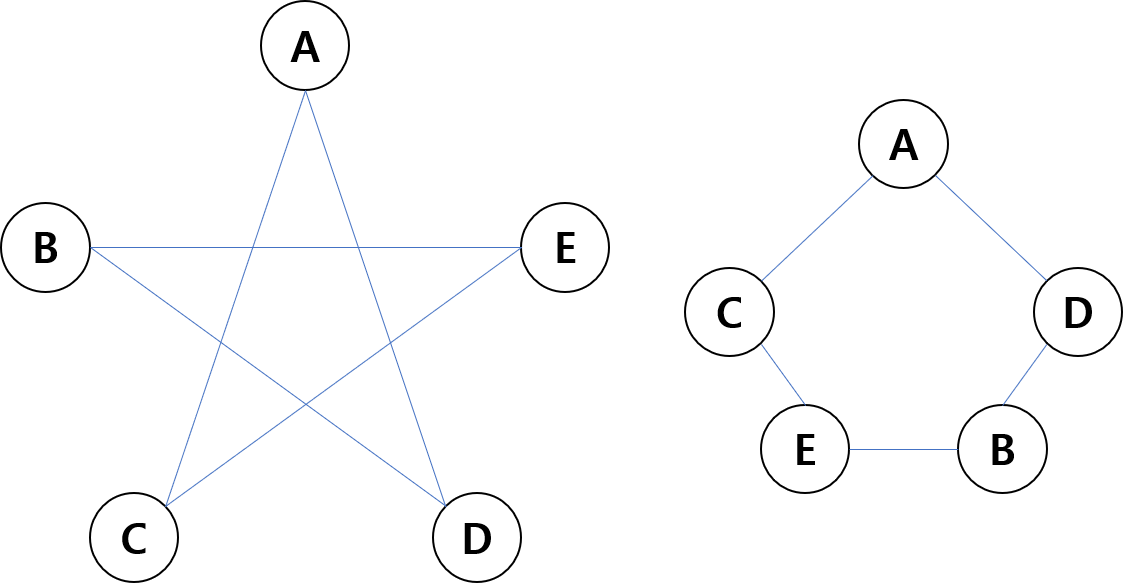문 제

소 스 코 드
#include <iostream>
#include <map>
#include <set>
#include <vector>
#include <queue>
#include <stack>
typedef std::map<int, std::set<int>> Graph;
typedef std::vector<int> Answer;
void DFS(Graph&, const int&, bool *, const int&);
void BFS(Graph&, const int&, bool *, const int&);
int main() {
std::ios_base::sync_with_stdio(false);
std::cin.tie(NULL);
std::cout.tie(NULL);
int N, M, V;
std::cin >> N >> M >> V;
bool *num{ new bool[N + 1] };
Graph nodes;
int firstDot, secondDot;
for (int i = 0; i < M; ++i) {
std::cin >> firstDot >> secondDot;
nodes[firstDot].insert(secondDot);
nodes[secondDot].insert(firstDot);
}
// DFS, start dot : V
DFS(nodes, V, num, N);
// BFS
BFS(nodes, V, num, N);
delete[] num;
}
void DFS(Graph& g, const int& start, bool * arr, const int& N) {
std::fill_n(arr, N + 1, false);
Answer answer;
answer.reserve(g.size());
std::stack<int> st;
st.push(start);
arr[start] = true;
answer.emplace_back(start);
while (!st.empty()) {
int index{ st.top() };
for (auto iter = g[index].begin(); ; ++iter) {
if (g[index].end() == iter) {
st.pop();
break;
}
if (false == arr[(*iter)]) {
st.push(*iter);
arr[*iter] = true;
answer.emplace_back(*iter);
break;
}
}
}
for (const auto& a : answer) std::cout << a << " ";
std::cout << '\n';
return;
}
void BFS(Graph& g, const int& start, bool * arr, const int& N) {
std::fill_n(arr, N + 1, false);
Answer answer;
std::queue<int> logs;
answer.reserve(g.size());
arr[start] = true;
answer.emplace_back(start);
logs.push(start);
while (!logs.empty()) {
int index{ logs.front() };
logs.pop();
for (const auto& a : g[index]) {
if (false == arr[a]) {
logs.push(a);
answer.emplace_back(a);
arr[a] = true;
}
}
}
for (const auto& a : answer) std::cout << a << " ";
std::cout << '\n';
return;
}
풀 이
BFS란, Breadth First Search 의 약자로 너비를 우선으로 탐색합니다.
DFS란, Depth First Search 의 약자로 깊이를 우선으로 탐색합니다.

만약, A ~ D의 정점이 존재하고, 5개의 간선이 존재한다고 합니다.
이 그래프는 시작이 A라는 가정하에, 오른쪽과 같이 표현 할 수 있다.
이 때,
1층은 A
2층은 C, D
3층은 E, B
BFS를 할 경우, 너비 우선 탐색 이기 때문에, A -> C -> D -> E -> B 순으로 탐색이 됩니다.
DFS의 경우, 깊이 우선 탐색 이기 때문에, A -> C -> E -> D -> B 순으로 진행 됩니다.
만약 이 그래프에 하나의 노드가 더 있다고 할 때,

BFS와 DFS의 진행 순서는
BFS, A -> C -> D -> ? -> E -> B
DFS, A -> C -> ? -> E -> D -> B
구현을 할 경우,
BFS : A -> C -> D -> ? -> E -> B
DFS : A -> C -> ? -> C -> E -> C -> A -> D -> B
순으로 진행한다고 생각을 하여,
BFS의 경우에는 STL queue를 사용하였고,
DFS의 경우에는 STL stack을 사용하여 구현을 하였습니다.
출 력 값

문 제 출 처
문제 링크 : www.acmicpc.net/problem/1260
1260번: DFS와 BFS
첫째 줄에 정점의 개수 N(1 ≤ N ≤ 1,000), 간선의 개수 M(1 ≤ M ≤ 10,000), 탐색을 시작할 정점의 번호 V가 주어진다. 다음 M개의 줄에는 간선이 연결하는 두 정점의 번호가 주어진다. 어떤 두 정점 사
www.acmicpc.net
'[ ALGORITHM ] > [ 백 준 ]' 카테고리의 다른 글
| [BAEKJOON] 2667번 : 단지 번호 붙이기 (0) | 2020.08.30 |
|---|---|
| [BAEKJOON] 2606번 : 바이러스 (0) | 2020.08.29 |
| [BAEKJOON] 10942번 : 팰린드롬? (0) | 2020.08.27 |
| [BAEKJOON] 7579번 : 앱 (0) | 2020.08.26 |
| [BAEKJOON] 1520번 : 내리막 길 * (0) | 2020.08.25 |